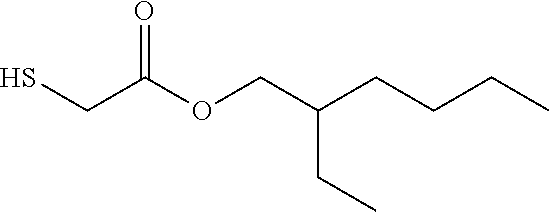Low migration free radical radiation curable inkjet inks
a free radical radiation and inkjet technology, applied in the field of free radical radiation curable inkjet ink, can solve the problems of limiting the possibilities of inkjet printing food packaging applications, unreacted polyfunctional monomers getting trapped in the polymerized network, and becoming increasingly difficult to avoid small amounts of residual unreacted monomers, so as to achieve high monomer conversion and increase ink viscosity
- Summary
- Abstract
- Description
- Claims
- Application Information
AI Technical Summary
Benefits of technology
Problems solved by technology
Method used
Image
Examples
example 1
[0234]This example illustrates the advantage in viscosity and migration performance of free radical radiation curable inkjet inks according to a preferred embodiment of the present invention.
Preparation of Free Radical Radiation Curable Inkjet Inks
[0235]The free radical radiation curable inkjet inks INK-1 to INK-9 were prepared to have a composition according to Table 5 or Table 6. The inkjet inks INK-2, INK-4, INK-6 and INK-8, respectively the inkjet inks INK-3, INK-5, INK-7 and INK-9, include the thiol compound so that the molar concentration of thiol groups in the ink is comparable. The percentages are weight percentages relative to the total weight of the radiation curable inkjet inks. The viscosity of each inkjet ink was determined.
[0236]
TABLE 5wt % ofINK-1INK-2INK-3INK-4INK-5DISP-116.016.016.0 16.016.0TX-145.045.045.045.045.0IC8192.52.52.52.52.5SC 70401.51.51.51.51.5Type I5.05.05.05.05.0Stabilizer1.01.01.01.01.0VEEA29.024.520.026.524.0Thiol-1—4.59.0——Thiol-8———2.55.0
[0237]
TABL...
example 2
[0245]This example illustrates the increased monomer conversion in an allylether-acrylate containing free radical radiation curable inkjet ink.
Preparation of Free Radical Radiation Curable Inkjet Inks
[0246]The free radical radiation curable inkjet inks INK-10 and INK-11 were prepared to have a composition according to Table 9. The percentages are weight percentage relative to the total weight of the radiation curable compositions. The viscosity of each inkjet ink was determined.
[0247]
TABLE 9wt % of INK-INK-component:1011DISP-116.016.0Omnipol ™ TX5.05.0IC8195.05.0Speedcure ™ 7040 5.05.0Type IB5.05.0Thiol-3—5.52-allyloxyethyl63.057.5acrylateStabilizer1.01.0
Results and Evaluation
[0248]The free radical radiation curable inkjet inks INK-10 and INK-11 were coated on a PET175 substrate using a bar coater and a 6 μm wired bar. All coated samples were cured were cured using a Fusion DRSE-120 conveyer, equipped with a Fusion VPS / 1600 lamp (D-bulb). A first sample of each radiation curable com...
PUM
| Property | Measurement | Unit |
|---|---|---|
| viscosity | aaaaa | aaaaa |
| molecular weight | aaaaa | aaaaa |
| viscosity | aaaaa | aaaaa |
Abstract
Description
Claims
Application Information
 Login to View More
Login to View More - R&D
- Intellectual Property
- Life Sciences
- Materials
- Tech Scout
- Unparalleled Data Quality
- Higher Quality Content
- 60% Fewer Hallucinations
Browse by: Latest US Patents, China's latest patents, Technical Efficacy Thesaurus, Application Domain, Technology Topic, Popular Technical Reports.
© 2025 PatSnap. All rights reserved.Legal|Privacy policy|Modern Slavery Act Transparency Statement|Sitemap|About US| Contact US: help@patsnap.com



